Joy Neal Kidney's Blog, page 71
April 26, 2021
WPA Programs by the New Deal during the 1930s
Works Progress Adminstration (WPA), created by President Franklin Roosevelt’s New Deal in 1935, set up jobs for public works projects, such as the roadwork that Clabe Wilson was hired for in Dallas County, Iowa, and the remodeling of a building that became the Dexter Public Library and a community room.
It also sponsored projects in the arts, helping those already skilled in writing, acting, music, and drama.
Farm Security Administration
The FSA was begun in 1935 to help tenant farmers and sharecroppers. They wanted to document their efforts, which resulted in a most compelling collection of Depression Era photographs. They are available through the Library of Congress.
John M. Zielinski has documented some of the Iowa photos in his Unknown Iowa: Farm Security Administration Photos 1936-1941. I’m especially drawn to the ones of the children and families, and ones taken indoors before flash cameras were readily available.
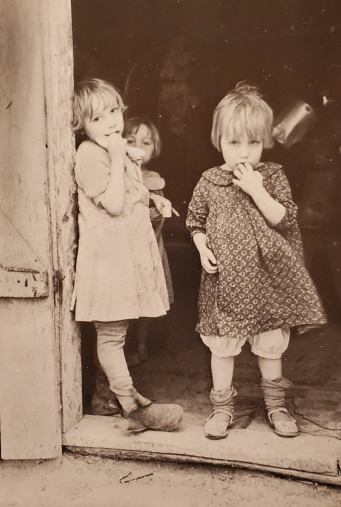 “SMITHLAND VICINITY “December 1936. The children of Earl Pauley in their home on submarginal farmland. Russell Lee.” Russell Lee was a photographer for Farm Security. From “Unknown Iowa: Farm Security Photos 1936-1941” by John M. Zielinski. I had to look up Smithland, Iowa. It’s in Woodbury County, near Sioux City.
“SMITHLAND VICINITY “December 1936. The children of Earl Pauley in their home on submarginal farmland. Russell Lee.” Russell Lee was a photographer for Farm Security. From “Unknown Iowa: Farm Security Photos 1936-1941” by John M. Zielinski. I had to look up Smithland, Iowa. It’s in Woodbury County, near Sioux City.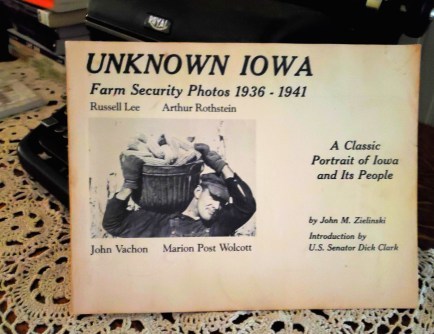 Photo on the cover: GRUNDY COUNTY October, 1939. A hired hand on the Fred Ukro farm with corn used in a test for the yield. Arthur Rothstein
Photo on the cover: GRUNDY COUNTY October, 1939. A hired hand on the Fred Ukro farm with corn used in a test for the yield. Arthur RothsteinArthur Rothstein will be featured in Wednesday’s blog post.
April 24, 2021
I See Guthrie Center First – a Poem
 Her glowing white hair appears on the porch,with her delighted grin. I see Grandma first!We spill out of the Chevy for hugs and patsand the most wonderful winsomeness ofbeing with Grandma Leora,no matter who got to see her first.
Her glowing white hair appears on the porch,with her delighted grin. I see Grandma first!We spill out of the Chevy for hugs and patsand the most wonderful winsomeness ofbeing with Grandma Leora,no matter who got to see her first.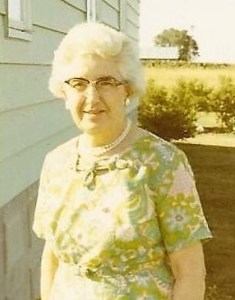
April 23, 2021
Iowa’s Grant Wood
I’ve always enjoyed Grant Wood’s artwork, but was reminded of it again with my immersion into Iowa during the Great Depression. Wood’s art is compelling and whimsical at the same time.
This children’s book is a nice overview of of his growing-up years, how his gift was developed, and how he was received as an artist in his own time.
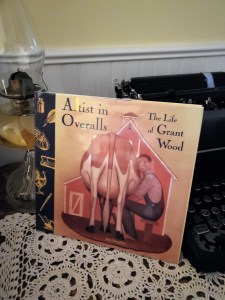
In the back is a section about “Drawing and Painting like Grant Wood,” leading to a handsome chicken. Those iconic chickens were a recurring theme in so much of his art.
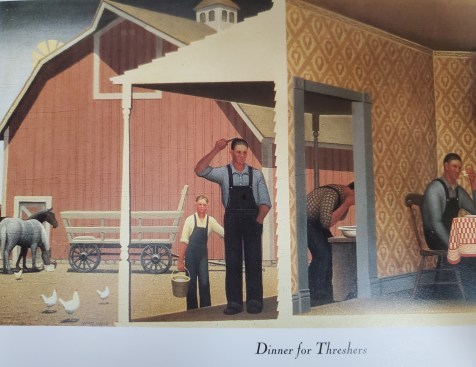 You can tell that dinner is at noon because of the shadows under the chickens! This is the left side of a delightful long painting of threshers having dinner in a farm kitchen. My mother loved it, so we framed a print of it for her, which my sister now enjoys in her kitchen.
You can tell that dinner is at noon because of the shadows under the chickens! This is the left side of a delightful long painting of threshers having dinner in a farm kitchen. My mother loved it, so we framed a print of it for her, which my sister now enjoys in her kitchen.Grant Wood’s work coincided with the Great Depression. I was interested in the designs he did for public murals, such as the ones in the library at Iowa State College (now University) at Ames, Iowa. He was state director of the Public Works of Art Project, an agency of the federal government to put artists to work. Remarkably, Wood donated his time for the project.
Eight staircase mural panels were painted in 1934, and were designed to reflect the different subjects taught at the land-grant college. Wood donated his services, but fourteen artists painted the murals. They used an old swimming pool at the University of Iowa in Iowa City, where Wood was an associate professors, as a studio.
The murals are still an attraction in the Iowa State University Library.
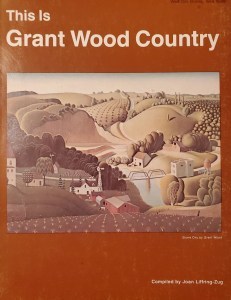
This book, compiled by Joan Liffring-Zug, has many photos of Grant Wood’s work in color, stories behind the scenes, and quote by people who knew and work with Iowa’s favorite artist in bib overalls.
April 21, 2021
Northshire Heritage (Stories from the Great War) by JP Robinson
The Northshire Heritage Trilogy

In the Shadow of Your Wings
“… Robinson’s eclectic array of characters and high-stakes scenarios make for an immersive beginning to a series that will appeal to fans of war dramas.”—Publisher’s Weekly
A past she can’t escape. A future he wants to make his own. A war that comes between them. She’s a spy in love with the enemy. Leila Durand, an elite German spy charged with infiltrating the home of British icon Thomas Steele, hopes to use the war to move beyond the pain of her shattered past. But everything changes when she falls in love with Thomas’s son, Malcolm. Is there a way to reconcile her love for Germany and her love for the enemy?
He’s a son who wants to break free. Malcolm, wealthy heir to Northshire Estate, wants nothing more than to be free of his father’s rules. When Thomas becomes too judgmental, Malcolm makes a life-changing choice.In the Shadow of Your Wings presents inescapable truth that resonates across the past century. Then as now, the struggle for faith is real. Then as now, there is a refuge for all who come beneath the shadow of God’s wings.
In the Midst of the Flames
“…dramatic and intricately plotted…”—PUBLISHER’S WEEKLY
Divided by a lie. Haunted by the past. Bonded by their love. As the fires of the Great War rage across the European continent, the Steele family is caught in the midst of the inferno.
Estranged from his wife Malcolm wonders if he can ever find forgiveness for his betrayal as he begins the long journey home. Leila desperately searches for a way to escape her past life as a spy—and the German agent who has been sent to kill her—as she struggles to prove her innocence.
Determined to save his family, Thomas risks everything in a high-stakes political gamble, bringing Britain to the brink of obliteration, as spymaster Robert Hughes plots his downfall.
Will everything be reduced to ashes? Or does God still walk with those who, through faith, step out into the midst of the flames?
A Christian author with a penchant for historical thrillers, JP Robinson places an unforgettable story against the backdrop of World War 1. In the Midst of the Flames is the unforgettable second installment of the Northshire Heritage trilogy. B“This should be a hit with fans of inspirational historicals.”—PUBLISHER’S WEEKLY
In the Dead of the Night
Darkness gathers in the final days of the Great War as the Germans plot to unleash a weapon that will plunge the Allied world into obscurity. For the Steele family, the stakes have never been higher. Leila is forced back into the shadows when the leader of a German spy ring kidnaps her child, jeopardizing Europe’s fragile bid for peace. Meanwhile, Malcolm fights to keep Northshire Estate as his father stands trial for treason against the British empire. Confronted with overwhelming circumstances from their past, the Steeles must rely on their grit and faith to conquer the night. But will it be enough?
The Author

JP Robinson is the President of Lancaster Christian Writers Association, minister, and educator. He has over 15 years experience in education and marketing. JP’s novels have garnered praise by industry leaders such as Publisher’s Weekly.
Note from the author: I’m a French and Social Studies teacher who loves God and loves telling a good story. I see writing as a chance to teach powerful lessons in an entertaining and memorable way. When I’m not glued to my computer drafting stories, I’m normally mentoring other authors, helping out with my church, and spending time with my amazing wife and kids.
My Thoughts
These are Christian historical thrillers, with fascinating back-stories. If you like stories set during the First World War, thrillers backed by real history, backed by powerful lessons, you’ll enjoy this compelling trilogy.
These historical novels, set during the Great War, include a rich cast of characters, treacherous women spies, and assassination plots. There’s an infant held hostage in the final book, a gripping tension-filled trial, and even a castle at stake.
Especially interesting are notes about the the author’s for this excellent series, and revelation of which characters are historical and which are based on real people.
Check out JP Robinson’s website. The Lancaster Christian Writers Conference is this weekend!
Recently, JP has experienced some racism and vandalism. His gracious response is on his Facebook page.
April 20, 2021
A Child’s Rocking Chair, Through the Decades
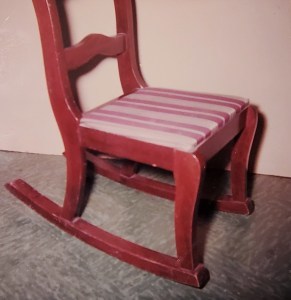
Probably for Christmas one year in the 1940s, Leora Wilson gave little rocking chairs to each of her six grandchildren.
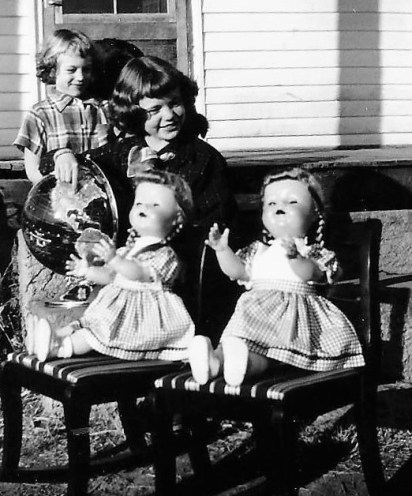 Gloria and I are entertaining our dolls, who are enjoying the little rockers. I’m pointing to where we live on the globe, which I still have.
Gloria and I are entertaining our dolls, who are enjoying the little rockers. I’m pointing to where we live on the globe, which I still have.I suppose this one, and my sister’s, were eventually relegated to a store room, as our old farmhouse didn’t have an attic. Both of us were 4-H members, in the Penn Township girls’ club called the Penn Gwens. We needed projects to complete, to record in our record books and for the Madison County Fair.
The little rocking chair became a project of painting and reupholstering it.
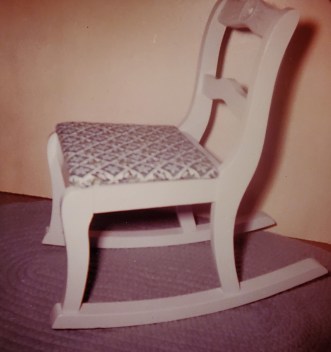 I noted that the name of the paint was Chiffon, and that I’d braided the rug, which was another project.
I noted that the name of the paint was Chiffon, and that I’d braided the rug, which was another project.

The fabric swatch gives you an idea of how much colored photos of that era have faded.
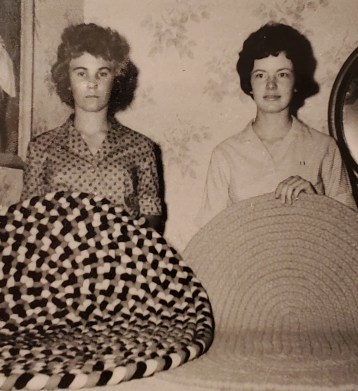 I’m sure Marilyn had more fun that it looks! Her rug was black, rose, and off white, made of old clothing. Mine was a light blue, made from a torn-apart electric blanket that no longer worked. Marilyn’s father, Bob Lawson, taught us the art of rug braiding.
I’m sure Marilyn had more fun that it looks! Her rug was black, rose, and off white, made of old clothing. Mine was a light blue, made from a torn-apart electric blanket that no longer worked. Marilyn’s father, Bob Lawson, taught us the art of rug braiding.Marilyn Lawson and I did a demonstration about making braided rugs from discarded clothing and blankets.
Meanwhile, I’d learned to do needlepoint. When son Dan was small, in the late 1970s, I refinished the chair. This time I designed and needlepointed upholstery for the seat.

Now the little rocking chair belongs to granddaughter Kate in the Twin Cities! She’s so busy, I don’t think she sit on it. Or anything else.

April 19, 2021
F/O Claiborne Junior Wilson
This was written for the Stories Behind the Stars website, which plans to remember every WWII fallen. They provided training and a certain format, including footnotes for research. They even offered to link them to Leora’s Letters: The Story of Love and Loss for An Iowa Family During World War II, but in order to do that I’d need to join something else.
By then, I was finishing up the manuscript for Leora’s Dexter Stories: The Scarcity Years of the Great Depression and was exasperated by trying to jump through all their hoops and gave up.
F/O Claiborne Junior Wilson
Killed in a Training Accident near Yorktown, TX
F/O Claiborne Junior Wilson – was born on July, 1925, near Dexter, Dallas County, Iowa. His father, Claiborne Daniel Wilson, and mother, Leora Frances Goff Wilson, were born and raised in Guthrie County, Iowa. His father was a farmer and raiser of championship Duroc Jersey hogs. Junior Wilson had two older brothers, who served in the US Navy during the Great Depression and WWII, and two older brothers, who were pilots lost during the war. He also had two sisters.
Junior Wilson grew up during the Great Depression in and around Dexter, Iowa,

graduated from Washington Township High School in 1942. He farmed with his father and brothers, tenant farmers near Minburn, Iowa, when the war broke out. Junior Wilson enlisted in the US Army Air Force September 1943.
Basic Training was at Sheppard Field, Wichita Falls, TX in late 1943. College Detachment was at Stilwater, OK, until March 1944. Preflight was at San Antonio, TX, until June 1944. Primary Cadet Training was at Curtis Field, Brady, TX until September 1944. Basic Training was at Majors Field, Greenville, TX, also Waco, TX, at the end of 1944. Advanced at Aloe AFB, Victoria, TX, graduating in the Class of 45-A. Transition Training was in P-40s at Foster and Aloe Fields, Victoria, TX.
F/0 Wilson was the pilot of a P-40 when the engine threw a rod and exploded in formation training, August 9, 1945, near Yorktown, TX, killing Junior, age 20.
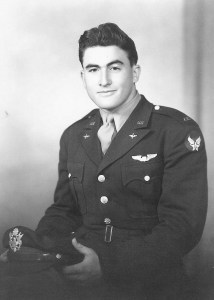
When the telegram arrived about his death, his parents expected confirmation about one of their two sons still listed as Missing in Action.
Five Wilson brothers served in the war. Only two came home. Junior Wilson is one of the three young pilots who lost their lives during the war. He is buried at Violet Hill Cemetery in Perry, Iowa.
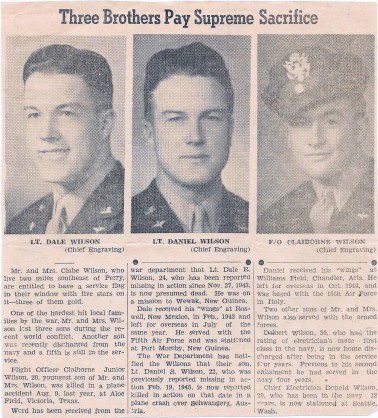
All five Wilson brothers are remembered on the Dallas County Freedom Rock at Minburn, Iowa.
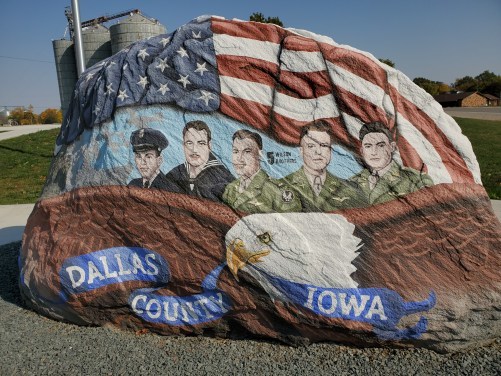
Sources:
Joy Neal Kidney has copies of Claiborne Junior Wilson’s Accident File, letters sent home, telegrams sent to his parents, newspaper clippings. Leora’s Letters: The Story of Love and Loss for One Iowa Family During World War II Stories about C. Junior Wilson FindagraveApril 17, 2021
Family History Reveals Conditions of Great Depression by Dennis L. Peterson
Reading someone else’s family history, especially when you are not remotely acquainted with that family and its various members, can be daunting. Downright confusing, in fact.
So it was with not a little trepidation that I agreed to read and review a pre-publication copy of Joy Neal Kidney’s latest book Leora’s Dexter Stories: The Scarcity Years of the Great Depression.

I was, however, pleasantly surprised by my experience. For the first several chapters, I was, indeed, a little confused as I tried to remember the various members of the large family that Kidney describes in the book. But I was soon able to see the larger picture as all the pieces began to come together and I became acquainted with each member she mentioned.
The Wilson family comprised the parents, Clabe and Leora Wilson, and their seven children, all but one of whose names began with the letter D (which added to my initial confusion!). From youngest to oldest, they were Junior, Danny, Darlene and Dale (twins), Doris, Donald, and Delbert. The book includes numerous photos of the family members help one quickly become familiar with them. Initial confusion quickly turns to insatiable curiosity about what happens to each of them, and I found myself not wanting to stop reading.
The names, faces, places, situations, and events of other families during the Depression might have been different, but the conditions of the time would have been similar for millions of average families across the nation during the trying years of the Great Depression. The scarcity of money, the constant struggle to feed the family, sickness and death, obstacles to advancement, numerous and varied jobs to make ends meet, and each family member’s mutual efforts to keep the family together are constant themes throughout the book. Yet, in spite of the hardships of the times, people still had fun, and the Wilson family was no exception. They played ball. They fixed up old cars. They celebrated Christmas and other holidays, albeit in limited ways. They sledded, exulting in their new sled. They went to school and learned. They lived, loved, and learned.
Kidney’s book, with short chapters, is fast paced. The narrative is filled with examples of folkways, customs, and ways of doing things that vividly reveal the time period. That lifestyle will be readily recognized by the older readers and will provide valuable insights of the earlier generation for younger readers.
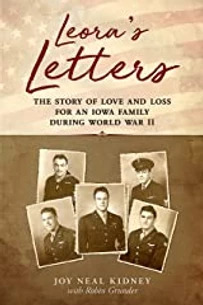
Leora’s Dexter Stories is Kidney’s second book, her first being Leora’s Letters: The Story of Love and Loss for an Iowa Family during World War II. In the earlier work, she tells the tragic story of how the Wilson family had five sons who served overseas during the war. Only two of the brothers returned.

Kidney describes herself on her Amazon author page as “the keeper of family stories, letters, pictures, research, combat records, casualty reports, and terrible telegrams.” She is “active on several history and military Facebook pages,” has written “two genealogies, as well as dozens of essays in newspapers and magazines,” and is a popular guest on the Our American Stories radio broadcast. The Iowa Women’s Archives of the University of Iowa include a collection of her essays.
If you’re interested in the events of the Depression and World War II and how those greater narratives affected everyday life for everyday people, these Kidney’s books are for you. With so many eyewitnesses of these two historic periods, it’s critical that such accounts be preserved and passed on to subsequent generations. Both books will be available on Amazon.
This was a nice surprise the morning I gave a talk at Earlham about these stories!
Dennis is the author of several books, including the delightful memoir, Look Unto the Hills: Growing Up in Rural East Tennessee.
April 16, 2021
National Poetry Month: Four More Favorites
I’ve also enjoyed these slim volumes of accessible verse:
Elements

Sorted by water, air, earth, and fire these nearly forty poems by Christopher Yokel are compelling in their nuance and images. I especially liked “Lux in Tenebris,” “Orion’s Repose,” “Gray and Green,” and “E Pluribus Me.”
The recurring phrase in “And It Was Night” is powerful in its chant.
—–
Soul Sketches

With some revised, some new, this new edition by Tim Ritter covers memories from childhood to the present. It’s an eclectic gathering of reflections and passions.
From the amusing “Candelabras and Scarlet Tights” to lying in the dirt with his son as Civil War reenactors for a film in “State Blood and French Fries,” it’s a fascinating collection. My favorite is the surprising and transcendent “Joseph’s Prayer.” A laudable collection.
—–
Prescriptions from the Rhyme Doctor

Allen Rizzi is a writer with over 55 years professional experience including non-fiction, biography, music, poetry and corporate analytic writing. He has additional expertise as a photographer, historical researcher and genealogist. Specialties: Historical non-fiction, nostalgia, public profiles, biographies, and documentary writing in English, Italian, and German. With skills in music composition and lyrics, Allen Rizzi has composed more than 200 songs since 1974.
Prescriptions from the Rhyme Doctor is divided into “The Young Man–Years of Hope” and “The Old Man–Years of Judgment.” It covers a span of about fifty years and certainly changes in style and focus. I especially enjoyed “I Remember Nonna” and “Genealogy,” both written in the author’s later years.
—–
Red Stilts

Ted Kooser is winner of the Pulitzer Prize for Poetry, for Delights and Shadows, and also served two terms as the Poet Laureate of the United States. He is the author of over twenty books, including five for children, he was born in Ames, Iowa, and lives in a small town in Nebraska.
There’s a reason this poet is much loved. His poetry is so full of compelling vignettes of the ordinary, urging the mesmerized reader to pause and become a noticer of details as well. I’d list my favorite, but there are at least ten of them. I just love this man’s compelling work.
My fibromyalgia symptoms got so miserable I thought I’d never be able to write again. I gave away all of my poetry books, including Kooser’s Delights and Shadows and The Poetry Home Repair Manual. I since have gratefully acquired new copies of both.
April 14, 2021
Keeping the Dexter Town Pump Oiled: a WPA Job During the 1930s
During the 1930s, the federal government enacted New Deal legislation to create jobs for the thousands who had lost theirs and couldn’t find work at all.

One WPA job in Dexter kept the town pump oiled a few hours each week.
In June of 1934, Clabe Wilson began the part-time government job which lasted nearly a year. A brick hut housed the machinery on the southwest corner of town, out toward the cemetery. Clabe was allowed to work sixteen hours a week.
 The old Dexter pumphouse, photo probably taken in the early 1990s
The old Dexter pumphouse, photo probably taken in the early 1990sHe still worked there in during that winter. It was desolate and cold inside the little brick pumphouse, with nothing to do but keep the pump oiled. Clabe wore long johns all winter, and bundled up for the half-day shift with everything warm he could find.

I’ve never been able to learn whether this was an essential job, or a make-work one.
The town pump made its way into family letters to the Wilsons’ sons who’d joined the navy as a result of not having jobs. And it’s part of the history of Dexter, Iowa, during the scarcity years of the Great Depression.
Leora’s Dexter Stories: The Scarcity Years of the Great Depression is due out later this spring. There aren’t photos of the pumphouse in the book, since they’re hard to see very well.
 The old pumphouse was in the green triangle area in the upper left of this map.
The old pumphouse was in the green triangle area in the upper left of this map.
If you take the street north from the triangle, it will take you across the Rock Island tracks and to Drew’s Chocolates on the highway. Keep going north and you’ll see the marker for the 1948 National Plowing Match, where an estimated 100,000 sweltering souls came to hear President Truman speak.
Farther north are markers for Dexfield Park and for the Bonnie and Clyde shootout. Both of these have chapters in Leora’s Dexter Stories. Drew’s Chocolates also makes a cameo appearance.
April 13, 2021
Join Me Thursday in Person or Via Facebook: Earlham’s Senior Speaker Series
The Earlham Senior Speaker Series invited me back! The talk about Leora’s Depression Era stories was to be a year ago, but a virus canceled in-person meetings. I promise this won’t be a depressing presentation.
You may enter on the east and climb a flight of stairs, or from the north to use the elevator. It’s their Senior Series, but they won’t check your ID to see if you’re old enough.

It will be streamed (10 a.m. Central Daylight Time) on the Bricker-Price Block Facebook page. Last week’s was their first time, so was a little awkward and the sound was echo-y, but should be better Friday. It’ll be fun anyway!
—–
Located in Madison County, Iowa, in the small town of Earlham, the Bricker-Price Block (consisting of C.D. Bricker Building, 115 S. Chestnut Ave. on the south, and W. Price Building, 105 S. Chestnut Ave. on the north) occupies the prominent southwest corner at the intersection of First Street and Chestnut Avenue in the Earlham central business district.

Built in 1900 to house the C.D. Bricker grocery and general store business and leased commercial space in the W.P. Price Building, with second-floor offices above each, the Bricker-Price Block also includes a 1919 one-story rear warehouse addition to the Bricker Building.
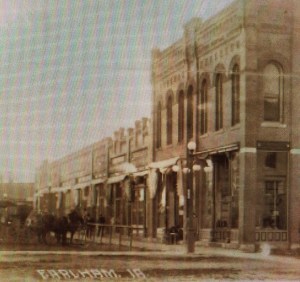
These two adjoining but separately owned buildings were built at the same time by the same builder with a unified façade and matching cast-iron storefronts, and thus the two buildings are jointly known historically as the Bricker-Price Block.



